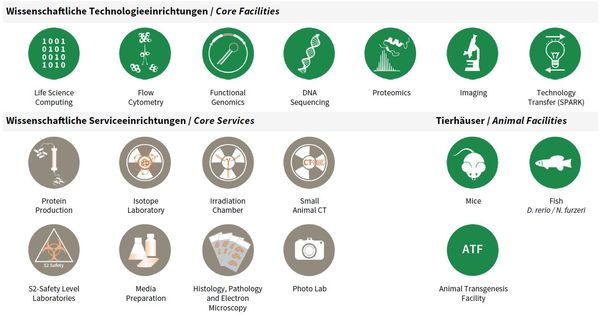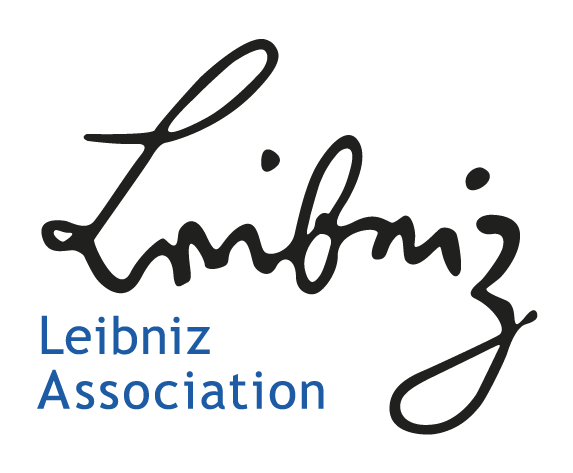Core Facilites and Core Services
At the beginning of 2016, a “core” structure was put into effect that organized facility and service units as independent organizational entities from FLI’s research groups. A number of technology platforms (e.g. sequencing, mass spectrometry) grew out of individual methodological requirements for single research groups in the last years but developed into semiautonomous substructures. As consequence of re-focused research activities and the concomitant advent of new research groups at FLI, those units increasingly had to serve many FLI groups and collaborative research efforts in the Jena research area.
To accommodate this development and to increase efficiency as well as transparency for users, facility personnel and for administrative processes, it came natural to re-organize such activities into independent units as “FLI Core Facilities and Services” and to phase out infrastructures considered non-essential for FLI’s research focus (X-ray crystallography and NMR spectroscopy).
FLI’s Core Facilities (CF) are managed by a CF Manager and are each scientifically guided in their activities and development by an FLI Group Leader, as Scientific Supervisor. The animal facilities comprising fish, mouse and transgenesis are run separately, as they involve a more complex organizational structure. Basic Core Services (CS) are directly led by the Head of Core (HC), who in turn is supported by individual CS Managers.
All facilities and services, including animal facilities, have a valuable contribution to FLI’s research articles; e.g. from 2016–2018, to 54% of all peer reviewed research publications.
Overview Core Facilities and Core Services at FLI.
Publications
(since 2016)
2023
- Tau alters global gene expression affecting chromatin in the early stages of Alzheimer’s disease
Siano* G, Varisco* M, Terrigno M, Wang C, Groth M, Galas MC, Hoozemans JJM, Cellerino A, Cattaneo** A, Di Primio** C
bioRxiv 2023, 10.1101/2023.11.17.567548 * equal contribution, ** co-senior authors - Light and prey influence the abundances of two rhodopsins in the dinoflagellate Oxyrrhis marina.
Westermann M, Hoischen C, Wöhlbrand L, Rabus R, Rhiel E
Protoplasma 2023, 260(2), 529-44 - Exploring the Diversity of Plant-Associated Viruses and Related Viruses in Riverine Freshwater Samples Collected in Berlin, Germany.
Zell R, Groth M, Selinka L, Selinka HC
Pathogens 2023, 12(12) - Hepeliviruses in two waterbodies in Berlin, Germany.
Zell R, Groth M, Selinka L, Selinka HC
Arch Virol 2023, 168(1), 9
2022
- Inhibition of Cdk5 increases osteoblast differentiation and bone mass and improves fracture healing.
Ahmad M, Krüger BT, Kroll T, Vettorazzi S, Dorn AK, Mengele F, Lee S, Nandi S, Yilmaz D, Stolz M, Tangudu NK, Vázquez DC, Pachmayr J, Cirstea IC, Spasic MV, Ploubidou A, Ignatius A, Tuckermann J
Bone Res 2022, 10(1), 33 - ProteasomeID: quantitative mapping of proteasome interactomes and substrates for in vitro and in vivo studies
Bartolome A, Heiby* JC, Dau* T, Di Fraia D, Heinze I, Kirkpatrick JM, Ori A
bioRxiv 2022, https://doi.org/10.1101/2022.08. * equal contribution - Partial Reduction in BRCA1 Gene Dose Modulates DNA Replication Stress Level and Thereby Contributes to Sensitivity or Resistance.
Classen S, Rahlf E, Jungwirth J, Albers N, Hebestreit LP, Zielinski A, Poole L, Groth M, Koch P, Liehr T, Kankel S, Cordes N, Petersen C, Rothkamm K, Pospiech** H, Borgmann** K
Int J Mol Sci 2022, 23(21) ** co-corresponding authors - A deep neural network provides an ultraprecise multi-tissue transcriptomic clock for the short-lived fish Nothobranchius furzeri and identifies predicitive genes translatable to human aging
Ferrari E, Reichwald K, Koch P, Groth M, Baumgart M, Cellerino A
bioRxiv 2022 - Osteocytes Serve as a Reservoir for Intracellular Persisting Staphylococcus aureus Due to the Lack of Defense Mechanisms.
Garcia-Moreno M, Jordan PM, Günther K, Dau T, Fritzsch C, Vermes M, Schoppa A, Ignatius A, Wildemann B, Werz O, Löffler B, Tuchscherr L
Front Microbiol 2022, 13, 937466 - CD44 Contributes to the Regulation of MDR1 Protein and Doxorubicin Chemoresistance in Osteosarcoma.
Gerardo-Ramírez M, Keggenhoff FL, Giam V, Becker D, Groth M, Hartmann N, Straub BK, Morrison H, Galle PR, Marquardt JU, Herrlich P, Hartmann M
Int J Mol Sci 2022, 23(15)









